The Kitchari Cleanse: An Ancient Detox Diet
Accomplish The Simple Goal Of Detoxification
Kitchari (kitch-ah-ree), a comfort food originating from India, is made with a lentils or “dal” (typically mung beans) combined with basmati rice, spices, various vegetables, lime and cilantro leaves. The word “kitchari” actually means mess, referring to the porridge-type nature of the dish. It is a warm, delicious and satisfying dish, but beyond taste it is packed with protein and nutrition that can sufficiently nourish your body for long periods of time.
India’s ancient Ayurveda is the oldest known medical practice in the world. The kitchari cleanse is an Ayurvedic home remedy or mono-diet for detoxifying the digestive system. A mono-diet is defined as a limited diversity in food consumed for a number of days. Through this simplification of diet, the digestive system is given a well-deserved rest, as the demand to produce multiple enzymes to break down different meats and processed foods are eliminated.
The kitchari is eaten two to three meals a day without consuming anything in between. Some allow for seasonal fruit as a snack, but others promote a more rigid approach of fasting in between meals. I chose the latter, and while restorative, fasting is very challenging and eye-opening to the many habits and dependencies I had in my daily diet.
Day 1
After a delightful two-hour yoga practice, I rush home to make my first pot of kitchari. My brain is already rationalizing and building a case against this diet. I nervously dive in, and cook my first pot using red lentils. I figured since I grew up eating red lentils it would be an old, familiar meal. Sure enough, my belly was full and all was calm.
A few hours after that first meal I am getting pretty hungry and resisting eating crumbs from my children’s plates. I hold strong and eat another bowl of the kitchari for lunch. I realize that the red lentils are a bit thick for this purpose, so I decide to make kitchari using mung beans the next day. You may use red lentils, split mung or mung beans. The mung bean is said to contain the highest in nutrition and best suited for this cleanse. I feel sharp pangs of hunger throughout the afternoon and cravings for sugar. I eat dinner uncharacteristically early at 4:45 p.m., the last bowl of the batch. It is recommended that a fresh pot of kitchari be cooked each day to preserve the composition and to avoid using the microwave. I leave a bowl of green organic mung beans to soak overnight. ]
Day 2
By morning, the mung beans had expanded and absorbed the water, making them much lighter and fluffier for cooking. Within 20 minutes the kitchari is ready. I add zucchini and tomatoes from my farm box, and by dinner the tomatoes taste like candy.
Flavors burst on my one-tracked palate.
I start to feel some changes in my senses and perspective. My daily priorities were shifting and no longer revolved around an afternoon iced tea or sweet snack. I struggle with hunger and lightheadedness in between meals. The satisfaction of carbohydrates was markedly missing from my day.
Day 3
I struggle in the morning with nothing to eat for the first few wakeful hours and felt light-headed. I allow myself one small slice of my son’s apple and power through the next couple of hours until it was a decent time to eat my first bowl of kitchari.
I decided that after three meals today I would conclude this cleanse and start a slow introduction to other foods while continuing to incorporate kitchari as part of my diet.
Days 4 & 5
I take my introduction of other foods at a slow pace. The digestion of these foods is not going unnoticed. I put a lot more thought into the foods I select in the wake of this cleanse. I avoid sugars and am extremely selective about what meats or fish I decide to consume.
Overall, this cleanse gave me a sense of calm over my digestive system and physical state. I slept soundly and woke up with purpose and a clear head. I kept my schedule pretty free over the few days of this cleanse, which enabled me to not only stay dedicated but to take lots of rest and drink plenty of water.
I dropped about one kilogram and visibly reduced water retention in my physique. I also felt more energy during daily activities. I have the luxury of having a relative who is a certified Ayurvedic consultant. A visit to an Ayurvedic practitioner would enable a far more customized cleanse program, but is not a requirement to accomplish the simple goal of detoxification.
There are many kitchari recipes out there to choose from, but below is the one I used. Try it for a cleanse or enjoy the benefits of a single meal. You can add or subtract vegetables and spices to satisfy your taste buds.
Recipe: Kitchari
Serves one.
Ingredients
- 1/4 cup organic split yellow mung beans or green mung beans
- 1/4 cup organic white basmati rice
- 1 and 3/4 cups spring water
- 1/4 inch slice organic fresh ginger
- 1/2 teaspoon organic turmeric powder
- 1/2 teaspoon organic coriander powder
- 1/2 teaspoon organic cumin powder
- ½ teaspoon organic cinnamon
- 1 tablespoon organic ghee (clarified butter)
- 1 pinch sea salt
- 1 organic lime wedge
- 1/4 cup fresh chopped organic cilantro leaves
Method
- Only the green mung beans require prior soaking in water.
- Bring water to a boil in a saucepan.
- Add beans, rice, ginger, and salt. Cover and simmer on low for 30 minutes until tender with a porridge-like consistency.
- In saucepan sauté spices in ghee for a minute, then mix into rice and beans. This is important to release the energy of the spices. You can also add steamed vegetables at this time. Top with cilantro and lime.
(Recommended optional vegetables include carrots, zucchini, cabbage, tomatoes, spinach and kale.)

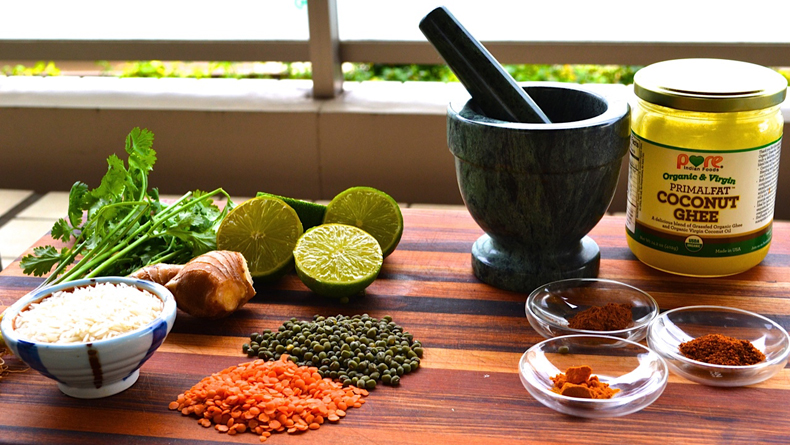
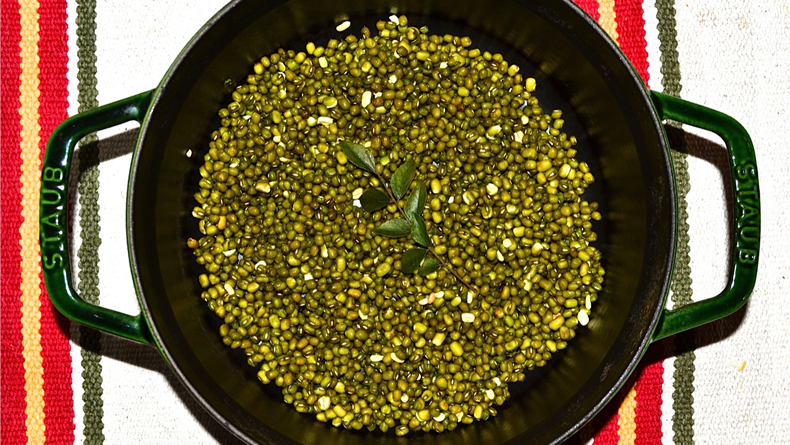
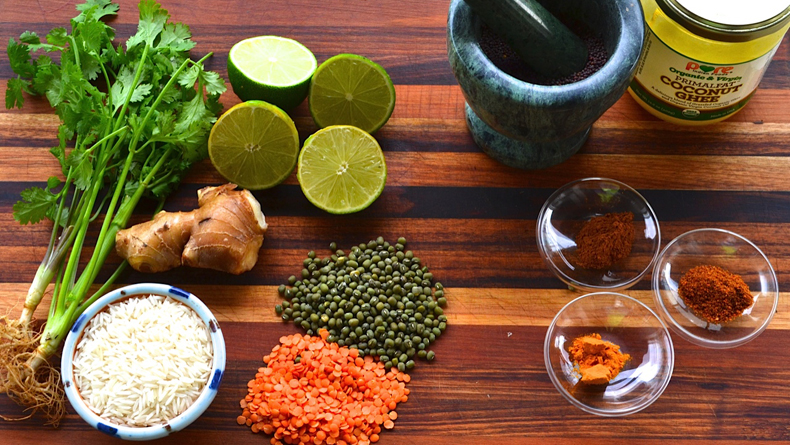
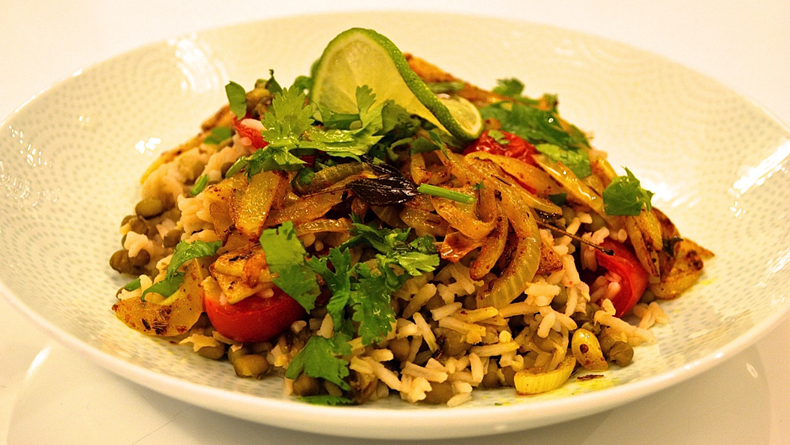













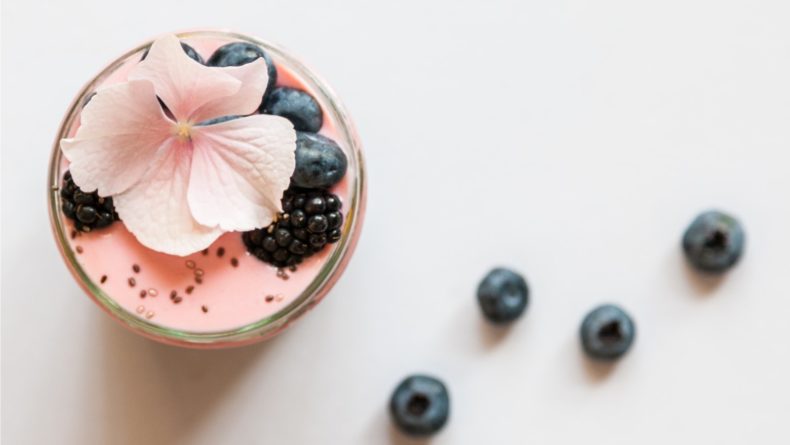

Leave a Reply